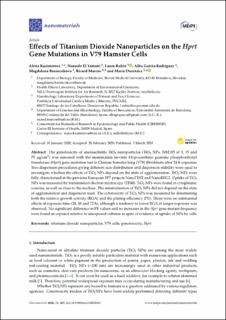| dc.contributor.author | Kazimirova, Alena | |
| dc.contributor.author | El Yamani, Naouale | |
| dc.contributor.author | Rubio, Laura | |
| dc.contributor.author | Garcia-Rodriguez, Alba | |
| dc.contributor.author | Barancokova, Magdalena | |
| dc.contributor.author | Marcos, Ricard | |
| dc.contributor.author | Dusinska, Maria | |
| dc.date.accessioned | 2020-03-19T09:21:29Z | |
| dc.date.available | 2020-03-19T09:21:29Z | |
| dc.date.created | 2020-03-16T14:33:42Z | |
| dc.date.issued | 2020 | |
| dc.identifier.citation | Nanomaterials. 2020, 10, 465. | en_US |
| dc.identifier.issn | 2079-4991 | |
| dc.identifier.uri | https://hdl.handle.net/11250/2647500 | |
| dc.description.abstract | The genotoxicity of anatase/rutile TiO2 nanoparticles (TiO2 NPs, NM105 at 3, 15 and 75 µg/cm2) was assessed with the mammalian in-vitro Hypoxanthine guanine phosphoribosyl transferase (Hprt) gene mutation test in Chinese hamster lung (V79) fibroblasts after 24 h exposure. Two dispersion procedures giving different size distribution and dispersion stability were used to investigate whether the effects of TiO2 NPs depend on the state of agglomeration. TiO2 NPs were fully characterised in the previous European FP7 projects NanoTEST and NanoREG2. Uptake of TiO2 NPs was measured by transmission electron microscopy (TEM). TiO2 NPs were found in cytoplasmic vesicles, as well as close to the nucleus. The internalisation of TiO2 NPs did not depend on the state of agglomeration and dispersion used. The cytotoxicity of TiO2 NPs was measured by determining both the relative growth activity (RGA) and the plating efficiency (PE). There were no substantial effects of exposure time (24, 48 and 72 h), although a tendency to lower RGA at longer exposure was observed. No significant difference in PE values and no increases in the Hprt gene mutant frequency were found in exposed relative to unexposed cultures in spite of evidence of uptake of NPs by cells. | en_US |
| dc.language.iso | eng | en_US |
| dc.rights | Navngivelse 4.0 Internasjonal | * |
| dc.rights.uri | http://creativecommons.org/licenses/by/4.0/deed.no | * |
| dc.title | Effects of Titanium Dioxide Nanoparticles on the Hprt Gene Mutations in V79 Hamster Cells | en_US |
| dc.type | Peer reviewed | en_US |
| dc.type | Journal article | en_US |
| dc.description.version | publishedVersion | en_US |
| dc.rights.holder | © 2020 by the authors. Licensee MDPI, Basel, Switzerland. | en_US |
| dc.source.pagenumber | 12 | en_US |
| dc.source.volume | 10 | en_US |
| dc.source.journal | Nanomaterials | en_US |
| dc.identifier.doi | 10.3390/nano10030465 | |
| dc.identifier.cristin | 1801870 | |
| dc.relation.project | EC/FP7/310584 | en_US |
| dc.relation.project | EC/H2020/814425 | en_US |
| dc.relation.project | Norges forskningsråd: 239199 | en_US |
| cristin.ispublished | true | |
| cristin.fulltext | original | |
| cristin.qualitycode | 1 | |

